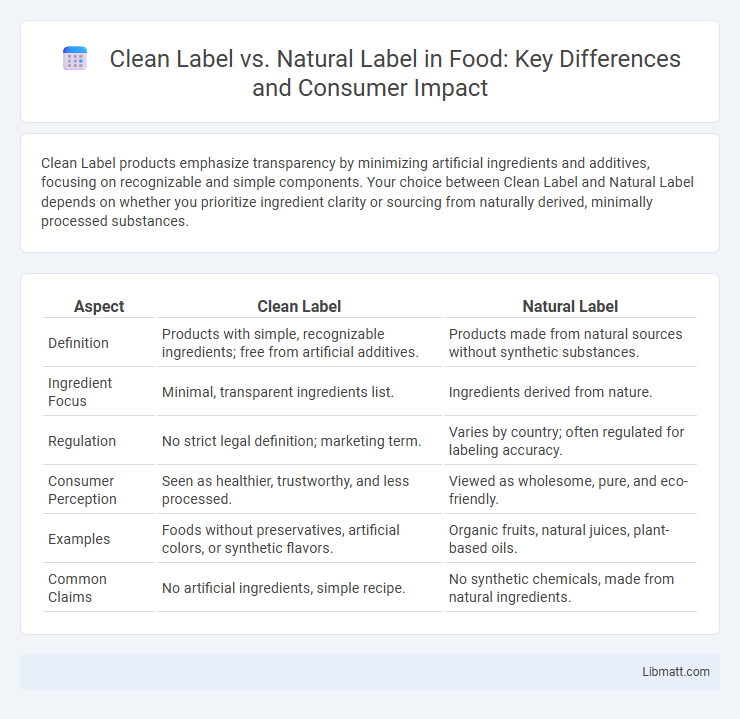Clean Label products emphasize transparency by minimizing artificial ingredients and additives, focusing on recognizable and simple components. Your choice between Clean Label and Natural Label depends on whether you prioritize ingredient clarity or sourcing from naturally derived, minimally processed substances.
Table of Comparison
| Aspect | Clean Label | Natural Label |
|---|---|---|
| Definition | Products with simple, recognizable ingredients; free from artificial additives. | Products made from natural sources without synthetic substances. |
| Ingredient Focus | Minimal, transparent ingredients list. | Ingredients derived from nature. |
| Regulation | No strict legal definition; marketing term. | Varies by country; often regulated for labeling accuracy. |
| Consumer Perception | Seen as healthier, trustworthy, and less processed. | Viewed as wholesome, pure, and eco-friendly. |
| Examples | Foods without preservatives, artificial colors, or synthetic flavors. | Organic fruits, natural juices, plant-based oils. |
| Common Claims | No artificial ingredients, simple recipe. | No synthetic chemicals, made from natural ingredients. |
Understanding Clean Label: Definition and Scope
Clean Label refers to food products formulated with simple, recognizable ingredients that consumers perceive as wholesome and minimally processed, emphasizing transparency and trust in ingredient sourcing. It encompasses clear labeling practices that avoid artificial additives, preservatives, or ambiguous chemical names, aiming to meet increasing consumer demand for healthier and more natural food options. The scope of Clean Label extends beyond ingredient lists to include ethical considerations and sustainability, reflecting a broader movement toward clean, transparent, and responsibly produced foods.
What Does ‘Natural Label’ Really Mean?
The term "Natural Label" lacks a standardized definition, often leading to confusion about the authenticity and origin of ingredients listed. Unlike "Clean Label," which emphasizes simple, recognizable, and minimal ingredients, "Natural Label" may include ingredients perceived as natural but still subject to processing or additives. Understanding the nuances of "Natural Label" helps you make informed decisions by scrutinizing ingredient lists beyond marketing claims.
Key Differences: Clean Label vs Natural Label
Clean Label emphasizes transparent, minimal ingredients without artificial additives, ensuring simplicity and consumer trust, while Natural Label highlights products derived from natural sources with limited processing. Your choice depends on whether ingredient clarity or origin authenticity is more important in your product. Understanding these distinctions helps optimize marketing strategies and meet consumer expectations effectively.
Consumer Perceptions and Buying Trends
Consumer perceptions of clean label products emphasize transparency, simplicity, and minimal processing, with ingredients that are easily recognizable and free from artificial additives, driving a growing demand for such goods. Natural label items are associated with ingredients sourced from nature, often perceived as healthier, but sometimes generate skepticism due to lack of standardized definitions and potential use of additives. Buying trends reveal a strong preference for clean label products among health-conscious shoppers prioritizing ingredient clarity, while natural label appeals to those seeking organic or minimally altered foods, influencing product development and marketing strategies in the food industry.
Ingredient Transparency and Label Clarity
Clean Label emphasizes ingredient transparency by listing recognizable, minimally processed components to assure consumers of product purity and simplicity. Natural Label highlights the use of naturally sourced ingredients but may allow for some processing or additives, potentially leading to less clear definitions on the label. Clear labeling practices under Clean Label standards foster better consumer trust by avoiding ambiguous terms and ensuring straightforward ingredient disclosures.
Regulatory Standards for Clean and Natural Labels
Regulatory standards for clean labels emphasize transparency, requiring brands to list all ingredients clearly and avoid synthetic additives, artificial colors, and preservatives. Natural label regulations vary by country but generally mandate that ingredients be derived from natural sources without genetic modification or synthetic processing. Both labels face ongoing scrutiny to ensure consumer trust and compliance with evolving food safety and labeling laws.
Clean Label Product Examples
Clean label product examples include simple, recognizable ingredients such as whole fruits, vegetables, and minimally processed grains like quinoa and brown rice. Products featuring no artificial additives, preservatives, or synthetic flavors, such as organic yogurt with live cultures or herbal teas with pure extracts, also embody the clean label trend. Your choice of clean label foods ensures transparency and trust by highlighting straightforward, natural components without hidden chemicals.
Natural Label Product Examples
Natural label product examples include organic fruits and vegetables, minimally processed nuts, and dairy products sourced from grass-fed animals. These items often carry certifications such as USDA Organic or Non-GMO Project Verified to assure consumers of their natural origin and minimal chemical intervention. Natural label products emphasize ingredients free from synthetic pesticides, artificial additives, and genetically modified organisms, aligning with consumer demand for transparency and purity.
Marketing Strategies: Clean Label vs Natural Label
Clean Label marketing strategies emphasize transparency and simplicity by highlighting ingredient lists free from artificial additives, appealing to health-conscious consumers seeking trust and clarity. Natural Label campaigns focus on sourcing and minimal processing, leveraging terms like "organic," "non-GMO," and "eco-friendly" to connect with environmentally aware and holistic lifestyle buyers. Both strategies use targeted messaging but differ in consumer priorities--Clean Label targets ingredient purity, while Natural Label stresses origin and sustainability.
Future Outlook: The Evolution of Labeling Practices
Clean Label and Natural Label trends are driving companies to prioritize transparency and ingredient simplicity in product formulations. Future labeling practices will likely emphasize clear definitions and regulatory alignment to meet consumer demand for both clean and naturally sourced ingredients. Your purchasing decisions will benefit from labels that accurately reflect product integrity and sustainability commitments.
Clean Label vs Natural Label Infographic

 libmatt.com
libmatt.com